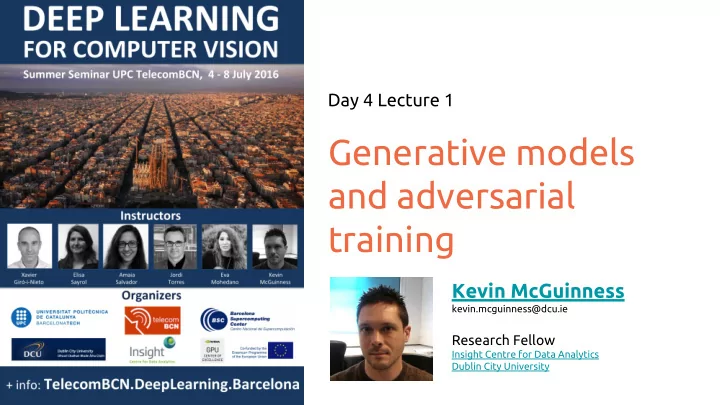

Day 4 Lecture 1 Generative models and adversarial training Kevin McGuinness kevin.mcguinness@dcu.ie Research Fellow Insight Centre for Data Analytics Dublin City University
What is a generative model? A model P(X; ϴ) that we can draw samples from. P(X = x) E.g. A Gaussian Mixture Model ● Fitting: EM algorithm x ● Drawing samples: ○ Draw sample from categorical distribution to select Gaussian ○ Draw sample from Gaussian GMMs are not generally complex enough x to draw samples of images from.
Why are generative models important? ● Model the probability density of images ● Understanding P(X) may help us understand P(Y | X) ● Generate novel content ● Generate training data for discriminative networks ● Artistic applications ● Image completion ● Monte-carlo estimators
Generative adversarial networks New method of training deep generative models Idea: pit a generator and a discriminator against each other Generator tries to draw samples from P(X) Discriminator tries to tell if sample came from the generator or the real world Both discriminator and generator are deep networks (differentiable functions) Can train with backprop: train discriminator for a while, then train generator, then discriminator, …
Generative adversarial networks (conceptual) Real world Sample images Real Loss Discriminator Latent random variable Fake Generator Sample
The generator Deterministic mapping from a latent random vector to sample from q(x) ~ p(x) Usually a deep neural network. E.g. DCGAN:
The discriminator Parameterised function that tries to distinguish between samples from real images p(x) and generated ones q(x). Usually a deep convolutional neural network. conv conv F F ...
Training GANs Alternate between training the discriminator and generator Differentiable module Real world Sample images Real Loss Discriminator Latent random variable Fake Generator Sample Differentiable module
1. Fix generator weights, draw samples from both real world and generated images 2. Train discriminator to distinguish between real world and generated images Real world Sample images Real Loss Discriminator Latent random variable Fake Generator Sample Backprop error to update discriminator weights
1. Fix discriminator weights 2. Sample from generator 3. Backprop error through discriminator to update generator weights Real world Sample images Real Loss Discriminator Latent random variable Fake Generator Sample Backprop error to update generator weights
Training GANs Iterate these two steps until convergence (which may not happen) ● Updating the discriminator should make it better at discriminating between real images and generated ones ( discriminator improves ) ● Updating the generator makes it better at fooling the current discriminator ( generator improves ) Eventually (we hope) that the generator gets so good that it is impossible for the discriminator to tell the difference between real and generated images. Discriminator accuracy = 0.5
Some examples…
Source: https://openai.com/blog/generative- ImageNet models/
Source: https://openai.com/blog/generative- CIFAR-10 models/
Credit: Alec Radford Code on GitHub
Credit: Alec Radford Code on GitHub
Issues Known to be very difficult to train: ● Formulated as a “game” between two networks ● Unstable dynamics: hard to keep generator and discriminator in balance ● Optimization can oscillate between solutions ● Generator can collapse Possible to use supervised labels to help prevent this: https://arxiv.org/abs/1606. 03498
Predicting the future with adversarial training Want to train a classifier to predict the pixels in frame (t+K) from pixels in frame t. Many possible futures for same frame Using supervised classification results in blurry solutions: loss if minimized if classifier averages over possibilities when predicting. We really want a sample, not the mean Adversarial training can solve this: easy for an adversary to detect blurry frames Mathieu et al. Deep multi-scale video prediction beyond mean square error , ICLR 2016 (https://arxiv.org/abs/1511.05440)
Mathieu et al. Deep multi-scale video prediction beyond mean square error , ICLR 2016 (https://arxiv.org/abs/1511.05440)
Summary Adversarial networks pit a generator network against a discriminator (adversary) Can be trained to draw realistic sharp samples Training can be difficult: can oscillate or generator can collapse
Recommend
More recommend